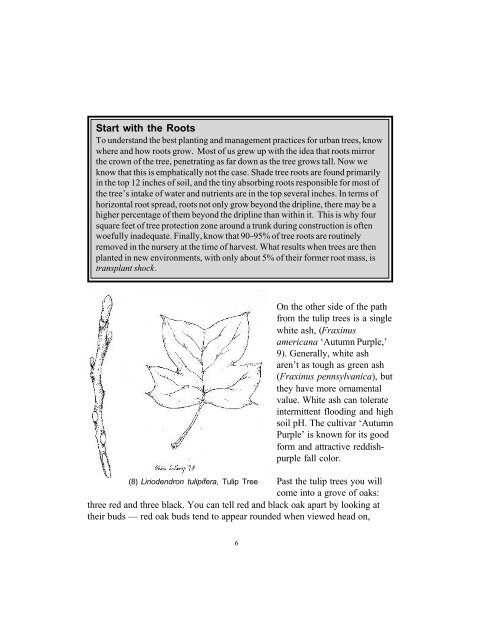Recommended Urban Trees: A Cornell Campus Walk - Horticulture ...
Recommended Urban Trees: A Cornell Campus Walk - Horticulture ...
Recommended Urban Trees: A Cornell Campus Walk - Horticulture ...
Create successful ePaper yourself
Turn your PDF publications into a flip-book with our unique Google optimized e-Paper software.
Start with the Roots<br />
To understand the best planting and management practices for urban trees, know<br />
where and how roots grow. Most of us grew up with the idea that roots mirror<br />
the crown of the tree, penetrating as far down as the tree grows tall. Now we<br />
know that this is emphatically not the case. Shade tree roots are found primarily<br />
in the top 12 inches of soil, and the tiny absorbing roots responsible for most of<br />
the tree’s intake of water and nutrients are in the top several inches. In terms of<br />
horizontal root spread, roots not only grow beyond the dripline, there may be a<br />
higher percentage of them beyond the dripline than within it. This is why four<br />
square feet of tree protection zone around a trunk during construction is often<br />
woefully inadequate. Finally, know that 90–95% of tree roots are routinely<br />
removed in the nursery at the time of harvest. What results when trees are then<br />
planted in new environments, with only about 5% of their former root mass, is<br />
transplant shock.<br />
6<br />
On the other side of the path<br />
from the tulip trees is a single<br />
white ash, (Fraxinus<br />
americana ‘Autumn Purple,’<br />
9). Generally, white ash<br />
aren’t as tough as green ash<br />
(Fraxinus pennsylvanica), but<br />
they have more ornamental<br />
value. White ash can tolerate<br />
intermittent flooding and high<br />
soil pH. The cultivar ‘Autumn<br />
Purple’ is known for its good<br />
form and attractive reddishpurple<br />
fall color.<br />
(8) Liriodendron tulipifera, Tulip Tree<br />
Past the tulip trees you will<br />
come into a grove of oaks:<br />
three red and three black. You can tell red and black oak apart by looking at<br />
their buds — red oak buds tend to appear rounded when viewed head on,

















